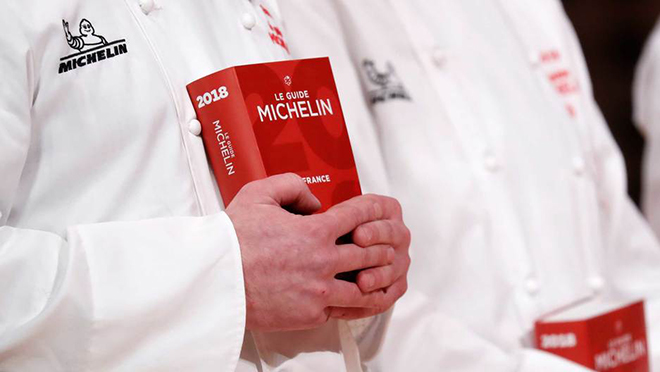Decidedly one of the highest symbols of status, professionalism and honor a restaurant can attain, chefs worldwide strive relentlessly all year round in hopes of earning the coveted Michelin star.
While best known for its tires, the Paris-based Michelin brand is also famous for its annual Michelin Guide, an online travel encyclopedia in support of local and international attractions. Initially published in 1900, the Michelin Guide only began incorporating a star-system in 1926 – emphasizing on the quality, flavor of food, mastery of culinary techniques and personality of dishes at restaurants seemingly overlooked or hidden in plain sight.
Despite its primary focus on the European region, in 2005, the guide published its first United States edition and soon the stars had spread across the globe – making Michelin stars the hallmark of fine dining by many of the world’s expert chefs and restaurant patrons.


According to Andrew Pern, chef owner of The Star at Harome, upon receiving a Michelin star, the restaurant’s turnover went up by an average of 22% per month and 60% overall. While Chef Pern describes the Michelin Guide as a “seal of approval” which massively alters both team morale and public perception.


The Michelin Guide ranks restaurants in accordance to the following criteria and categories:
One star: The restaurant is considered very good in its category but is limited in some way. This restaurant has a quality menu and prepares cuisine to a consistently high standard, but it may lack a unique element that would bring people back over and over again.
Two stars: The restaurant has excellent cuisine delivered in a unique way. This restaurant has something exceptional to offer and is worth a detour to visit while traveling.
Three stars: The restaurant has exceptional cuisine and is worth a special trip just to visit. Rather than being a stop on the way to a destination, this restaurant is the destination. This restaurant serves distinct dishes that are executed to perfection.


Judged by a panel of anonymous food enthusiasts with an eye for detail, these “inspectors” are prohibited from speaking to journalists and are encouraged to keep their line of work a secret even from close family members. An inspector’s job scope includes writing a comprehensive dining report on the restaurants visited – factoring in aspects such as food quality, presentation and culinary technique, while disregarding subjective elements such as décor, table setting and service standard. Each review is then followed up by an in-depth discussion amongst inspectors before shortlisted candidates are then awarded their stars.
Over time, Michelin star recipients have reported a significant increase in restaurant traffic, business and media exposure. However, not everyone seems as eager to be part of the Michelin guide – despite the innumerable perks, certain disapproving chefs consider the rank-system one of the cruelest tests in the world, forcing chefs to work year-round for a defining moment they will never know is coming or has passed.


South Korean Chef Eo Yun-gwon is one of the few that are currently rallying against the Michelin system. Suing the company for including his restaurant “Ristorante Eo” in their 2019 guide to Seoul without his consent, Eo has taken legal action under South Korean public insult or libel laws. Accusing the Michelin Guide of forcibly listing restaurants against their will and without a clear criteria, Eo is skeptical of the guide’s tight-lipped process in judging and maintains a strong belief that a handful of restaurants should not single-handedly be representative of a nation’s cuisine or culinary expertise.
While the ethics and candour behind gaining a star remain questionable, the effects of losing one, if not all, are clear as day. The cloud-nine high and success which often come with earning stars, plunge quickly with every loss. De-starred restaurants reportedly witness business nosedive almost instantly, placing great pressure on staff which may send some spiraling.
French chef, Marc Veyrat from the Haute-Savoie region who specializes in molecular gastronomy and the use of mountain plants and herbs experienced this first hand. With a resume of collecting a total of nine Michelin Stars in two restaurants, the loss of a single star sent him into a deep depression. In the eyes of Chef Marc, losing a star is the greatest dishonor and thus he is also suing Michelin for an “unfair review” based on the inspector’s misunderstanding of the specific ingredients. Similarly, Chef Pern described the loss of his Michelin star as “twice as destroying”.
In other cases, such as of Head Chef Gary Pearce who recalls when Ramon Farthing’s 36 on the Quay lost its star after 28 year consecutive years. Describing it as a confusing and directionless point in time, Chef Pearce even stated that the Michelin Guide failed to offer any feedback or explanation for its decision, leaving the entire team feeling gutted.
While it is perfectly normal for the rankings of any “exclusive list” to fluctuate, the consensus held by both sides who support and disapprove appear to be consistent. The secrecy surrounding the Michelin Guide’s operations and criteria have significant impact on the wellbeing and growth of restaurants and other smaller establishments – making the process of maintaining success a constant shot in the dark with real business consequences.

